List any possible reasons why you think South Africa would want to have a large population.
Learner-dependent answer. Might include: more people so more manpower and more taxes; might include religious or cultural bias; etc.
|
Previous
Chapter 2: Systems in the human body
|
Next
Chapter 4: Circulatory and respiratory systems
|
Chapter overview
2 weeks
After looking at several of the organ systems within the human body in overview in Chapter 2, the next three chapters will now look at some of these systems in more detail.
This chapter on "Human reproduction" starts off by looking at the purpose of reproduction and how humans mature during puberty in order to be able to reproduce. This will be very relevant to your learners as they are in this stage in their lives at the moment.
Be aware that learners might not feel comfortable discussing reproduction in the classroom, and older teens might laugh or make inappropriate jokes to conceal their own discomfort.
Some tips for when teaching human reproduction:
3.1 Purpose and puberty (2 hours)
|
Tasks |
Skills |
Recommendation |
|
Activity: Reflecting on population growth |
Identifying, predicting, writing |
Optional |
3.2 Reproductive organs (1 hour)
|
Tasks |
Skills |
Recommendation |
|
Activity: Identify the role of the male and female bodies in reproduction |
Identifying, writing |
Suggested |
|
Activity: Identify structure and function |
Identifying, describing, explaining, writing |
CAPS suggested |
|
Activity: Comparing the reproductive organs |
Comparing, summarising, writing |
Suggested |
3.3 Stages of reproduction (3 hours)
|
Tasks |
Skills |
Recommendation |
|
Activity: Flow diagram of the pathway of sperm |
Summarising, describing |
CAPS suggested |
|
Activity: Comparing fertilisation and menstruation |
Comparing, summarising, drawing |
Suggested |
|
Activity: Debate Surrogacy |
Working in groups, discussing, debating, presenting, writing |
CAPS suggested |
|
Activity: Describing different contraceptives |
Identifying, describing |
Optional |
|
Activity: Forum discussion |
Working in groups, discussing, debating, presenting, writing |
Optional |
At this stage in your life, your body is probably going through all sorts of changes as it grows, develops and matures. In this chapter we will learn more about these changes and why they occur.
You have previously learnt that reproduction is one of the seven life processes, and like all organisms, humans need to reproduce to ensure the survival of the species.
You can use this section to open up discussion about population growth and population control. At the end of the chapter there is a debate regarding contraceptives but teachers may choose to include a discussion on the different ethical points of view regarding contraceptives at this point already.
Video on our world population growth.
An interesting suggestion if you have an internet connection and a projector or smartboard to display a website, is to open up the link provided here in the visit box on our "Breathing Earth". This simulation very clearly shows how our population is growing. You can open up the link at the start of the lesson and leave it running for the duration. Then at the end of the lesson, you can see how much the population of the world has grown during your one lesson. Alternatively, if you do not have an internet connection in your classroom, ask some of your learners to take out their mobile phones and go to the site. Even if you only have a few mobile phones within the classroom, you can get learners to each take a look at the site at the start and end of the lesson. Do not be afraid to embrace the technology that your learners are using on a daily basis! They most likely have their cellphones in their pockets in class anyway, unless they have been banned during school hours.
A simulation to show population growth http://www.breathingearth.net/
Have a look at the website link provided in the visit box about our "Breathing Earth". This will give you an idea about how our population is growing.
In 2011 the world's population grew to 7 billion people, one billion more since 1999. Medical advances and increases in agricultural production (food) allow more and more people to live longer lives.
In ancient times, countries such as India, Rome and Greece, saw a large population as a source of power. The Romans even made laws about how many babies a couple could have and punished those who did not follow the rules. Yet Confucius (551-478 BC) thought that too many people was a problem, as there wouldn't be enough food to feed everyone, leading to war and famine and various other problems. Today in China this philosophy still applies and couples are only allowed one baby and are heavily taxed if they have more than one.
South Africa's population grew by 15,5%, or almost 7-million people, in the space of 10 years to reach a total of 51.7-million in 2011. This is according to the country's latest national census which took place in 2011. The last census took place 10 years previously in 2001.
QUESTIONS:
These questions are meant to stimulate discussion within your class. You can go through these as a class or learners can then do them individually and then discuss their answers.
List any possible reasons why you think South Africa would want to have a large population.
Learner-dependent answer. Might include: more people so more manpower and more taxes; might include religious or cultural bias; etc.
What are some advantages and disadvantages to the country in which the number of children per couple is limited so that the population growth is limited?
Advantages: lower population growth; lower pressure on the country's resources; lower drain on resources, particularly on the education resources; higher standard of living for families
Disadvantages: fewer people to pay taxes; religious or cultural non-compliance might lead to revolt
Predict what possible long-term problems might arise if the population in South Africa continues to grow at the fast rate at which it is currently growing.
With fewer resources to go around many might starve and since they might not have work or social grants to support them. Unemployment would increase even more. This might also lead to increased crime as people try to provide for themselves and their children, as well as drug and alcohol abuse as a coping mechanism.
Have a look at the following diagram which shows the percentage growth a country's population in a year. The different colours give an indication of the growth rate, as shown in the key. For example, countries which are colour coded yellow, have an annual growth rate of 3%. This means their population increase by 3% each year. Answer the questions which follow.
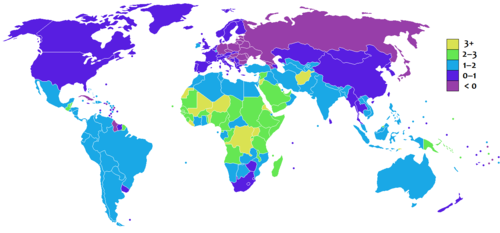
Which continent would you say has the largest percentage growth rate each year? Justify your answer.
Africa has the largest population growth rate. This can be seen as it has the largest number of countries which are coloured green and yellow which shows the highest annual percentage growth rate.
Many countries in Europe are coloured light purple in the diagram. What does this mean?
Learners need to look at the legend to see that light purple means a growth rate of "
Various population control methods are put in place around the world - contraceptives to stop women from falling pregnant, abortion clinics, large tax incentives to convince people not to want more children, and others. What is your opinion about population control methods and do you think they should be allowed in modern society?
Learner-dependent answer.
The science of overpopulation (video).
The human body is geared towards reproduction to ensure the survival of the species. Men have to produce sperm and ensure that they come into contact with a female egg cell. Women have to produce (and store) egg cells that can be fertilised by a male sperm cell.
Children's bodies and sexual organs are not mature and cannot yet perform the reproductive function. Puberty is therefore the time when a child's body develops and changes. The sexual organs mature to enable the body to produce sex cells. These sex cells are called gametes.
Puberty is the stage in the life cycle of humans when we become capable of sexual reproduction. Girls and boys do not, generally, go through puberty at exactly the same time. So how does puberty "start"?
Many of the complex actions that take place in our bodies are controlled by chemical messengers called hormones. Hormones are produced by different glands in our bodies. The pituitary gland is an important gland which controls most of the body's hormones and hormonal activities. It is about the size of a pea and located at the base of the brain.
This animation shows the position of the pituitary gland (the pink gland) http://upload.wikimedia.org/wikipedia/commons/9/9c/Rotating_brain_colored.gif
Puberty is brought on when the pituitary gland releases specific hormones into the bloodstream. These hormones then travel to the immature sex organs and signal the hormones in these to be released.
In girls, the ovaries are stimulated by hormones released by the pituitary gland to release the hormone oestrogen. In males, the testes are stimulated to release the hormone testosterone. These hormones initiate all the bodily changes that you experience during puberty.
The main purpose of puberty is for the sexual organs to mature. However, the hormones which are released from the reproductive organs also start a number of other changes in the human body. We call these secondary sexual characteristics.
Visit this interactive site to explore the changes that occur during puberty http://www.bbc.co.uk/science/humanbody/body/interactives/lifecycle/teenagers/
Puberty brings about the following secondary changes in females:
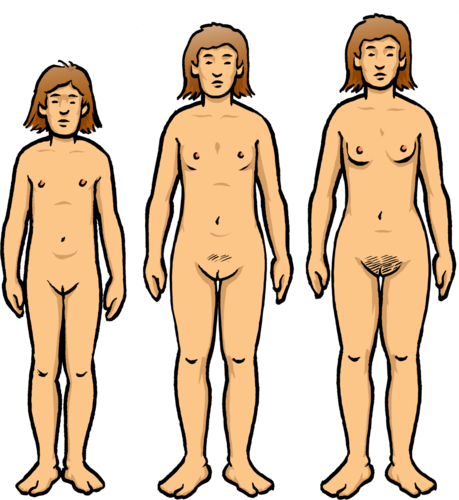
At the start of puberty boys are, on average, 2 cm shorter than girls, yet adult men are approximately 13 cm taller than adult women. Puberty brings about the following secondary changes in males' bodies:
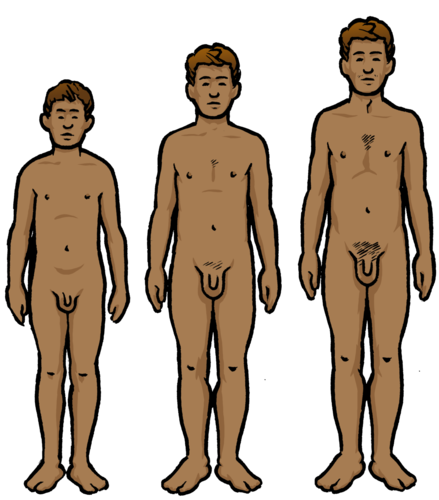
Let's take a look at the reproductive organs.
Let's take a closer look at the male and female reproductive organs to see how they are structured and what functions they perform.
In the space below, explain what you think the role of the male and female bodies are in reproduction.
The male body has to ...
The male body has to produce sperm and deliver this sperm to the female body in order for it to come into contact with the female egg (ovum).
The female body has to...
The female body has to produce ova (egg cells). Once a month, one egg cell is released and if a sperm cell penetrates the outer layer of the egg cell, fertilisation can take place. This may then lead to pregnancy and the female body adapts to provide for all the needs of the unborn baby before giving birth.
As you learn about the reproductive organs,think carefully about theirstructure and how their structure is adapted to their function.
The male reproductive organs include:
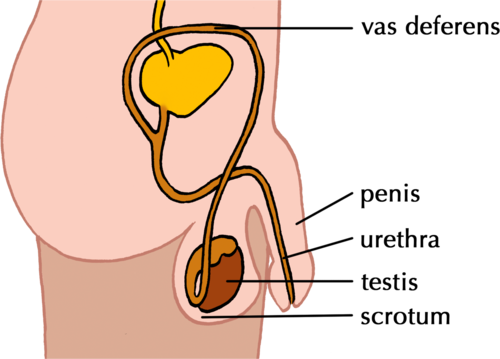
1. Testes and scrotum
Males are born with their two testes hanging outside their bodies. The testes in young boys do not produce sperm. During puberty the two testes release testosterone which then triggers the production of sperm.
Testes is plural and testis is singular.
Up until the 17th century, scientists believed that a tiny, fully formed human being called ahomunculus was passed from the father into the mother's womb during sexual intercourse and grew in size in the mother's womb.
The two testes are each contained in a pouch of skin called the scrotum. The scrotum ensures that the testes are kept at a constant temperature of 35°C which is the temperature at which sperm is produced.
Semen contains sperm cells, dissolved nutrients and enzymes that nourish and protect the sperm inside the woman's body. Every millilitre of semen can contain up to 100 million sperm cells!
2. Sperm duct (vas deferens)
Different tubes (ducts) carry the semen from the testes to the penis. The sperm duct carries the sperm from the testes to the urethra in the penis.
3. The penis
The penis is the external sex organ. The head is often covered by a loose fold of skin called the foreskin. The penis needs to be erect (stiff and hard) to be able to go into the vagina to deliver the sperm to the cervix during ejaculation.
Some cultures have the foreskin removed, which is called circumcision. This may be done when the boy is a baby or later, at puberty.
4. Urethra
The semen moves through the urethra to the outside during ejaculation. The urine passes through the urethra during urination, but the semen and urine do not move through the urethra at the same time.
This question starts to delve into the relationship of structures that are adapted to function. Learners need to LINK structure to function when examining any organ. This is an extension activity and requires learners to apply the knowledge they have just learnt.
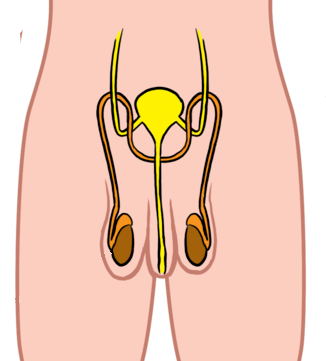
|
Reproductive Organ |
Function |
Adaptation |
|
Penis |
||
|
Testes and scrotum |
|
Reproductive Organ |
Function |
Adaptation |
|
Penis |
During sexual intercourse, the penis becomes erect and delivers the sperm into the cervix of the vagina. |
The penis is on the outside of the male body, and it is elongated so that it can insert into the vagina and deliver the sperm into cervix. The penis contains the urethra and becomes erect so that it can insert into the vagina. |
|
Testes and scrotum |
The testes produce the sperm and the scrotum hold the testes outside of the body. |
The testes need to be at 35 oC, which is lower than body temperature, in order to produce sperm. The testes are therefore outside of the male body and hang in the scrotum, which can adjust the temperature of the testes so that the right temperature is maintained in order to produce sperm. |
The plural of ovum is ova.
The female reproductive organs include:
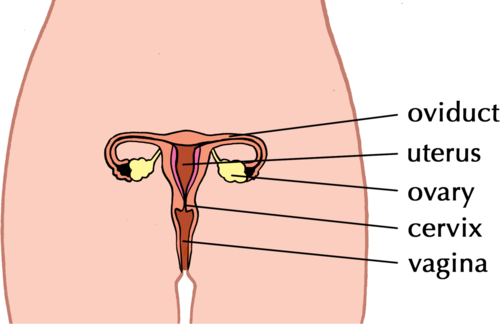
1. Vagina
The vagina is a tube that connects the uterus with the outside of the body. During intercourse the vagina acts as a canal for the penis to fit into to deliver sperm. Once a month, during menstruation, the menstrual blood leaves the body through the vagina. It is also the birth canal during childbirth when it stretches to allow the baby to pass through.
2. Uterus
The uterus is hollow with extremely strong muscular walls that can carry and protect a baby. Two oviducts (Fallopian tubes) at the top of the uterus, connect it to the ovaries. The bottom neck of the uterus is called the cervix, which is tightly closed to protect the inside of the uterus.
3. Ovaries
There are two ovaries on either side of the uterus. They produce oestrogen and contain the ova. Each month the ovaries take turns to produce a mature ovum. This is called ovulation.
Women are born with thousands of immature egg cells in each ovary, but very few ever reach maturity.
4. Oviducts (Fallopian tubes)
The uterus and ovaries are connected through a pair of muscular tubes called the oviducts or Fallopian tubes. The mature ovum travels into these tubes to the uterus. Fertilisation occurs in the oviduct.
Learn more about the female reproductive system at this site: http://kidshealth.org/teen/interactive/female_it.html#cat20129
Explain how the structures of the vagina, cervix and uterus are specially adapted to fulfil their functions.
The vagina is elastic and muscular so it can contain the penis during intercourse to prevent the sperm from running out. The cervix is situated at the top of the vagina approximately where the penis' ejaculated sperm will be. It is tightly closed to protect the uterus. It carries the sperm into the uterus which has a thick, blood-rich lining, ready for the implantation of the fertilised egg.
Provide at least 2 reasons why the uterus needs to have strong muscular walls.
The uterus needs to protect and carry the unborn child during pregnancy and it needs to contract and push out the baby during childbirth.
Compare the position and functions of the ovaries with that of the testes. Create a table to show these differences.
A possible table that learners might produce:
Differences between the female ovaries and the male testes
|
Characteristic |
Ovaries |
Testes |
|
Position |
Inside the body |
Outside the body |
|
Hormones produced |
Oestrogen |
Testosterone |
|
When gametes are produced |
Females are born with ova in their ovaries which mature once puberty is reached |
Males only start to produce sperm once they reach puberty |
|
Number of gametes released/produced |
Release one ovum per month |
Produce thousands of sperm daily |
|
Hormone influence |
Hormones in the ovaries stimulate the ovum which are already present so that they mature |
Only start to produce sperm under the influence of the hormones |
We have already mentioned most of the processes that take place during reproduction. These processes occur in stages. Let's first have a look at the female reproductive cycle.
The female reproductive cycle repeats every 28-30 days to release an egg cell to be fertilised if sperm are present. This cycle will repeat for many years from puberty to menopause (when the reproductive cycle comes to an end).
The processes that occur will differ depending on whether the ovum is fertilised or not. After ovulation, if fertilisation does not occur, the reproductive organs 'reset' through menstruation to start the process again.
Once a month, one of the ovaries releases one mature ovum into the oviduct.. This process is called ovulation. At the same time the uterus wall thickens and develops extra blood vessels. This is in preparation for the possible implantation of a fertilised egg.
There are times in the menstruation cycle near to ovulation when there is a high chance of becoming pregnant. All girls need to be aware of where they are in their own menstrual cycle as each cycle differs slightly.
Learn how to create an ovulation calendar to keep track of a menstrual cycle.
When there is no fertilised egg cell (zygote) to implant in the uterus, the thick layer of blood and tissue is no longer needed. It is passed out through the vagina during menstruation. The entire process is called the menstrual cycle and it normally repeats every 28-30 days.
Learn more about the menstrual cycle: http://kidshealth.org/teen/interactive/female_it.html#cat20129
During sexual intercourse the erect male penis enters the female vagina. This is called copulation.
The male penis deposits sperm into the female vagina through ejaculation. There can be millions of sperm cells in one ejaculation, but only one will be able to penetrate the outer membrane of the ovum.
After ejaculation into the vagina, the sperm swim into the cervix and through the uterus to the oviducts. Once inside the oviducts, the sperm swim to meet the mature egg that was released from the ovaries and is now traveling towards the uterus.
One sperm cell burrows into the surface of the ovum. Only the sperm's head enters, the tail stays outside. As soon as one has penetrated the outer layer, the surface of the ovum changes and no more sperm will be allowed to enter.
This process is called fertilisation and it takes place in the outer part of the oviduct, and not in the uterus or vagina.
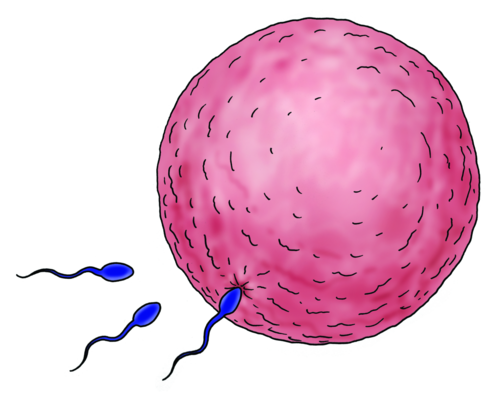
INSTRUCTIONS:
The following flow chart can be used as a reference for learners' flow charts:
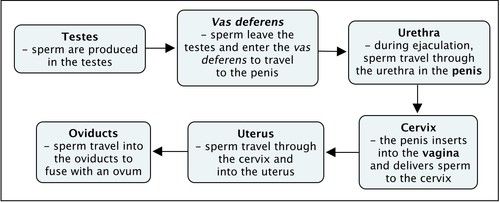
Video on fertilisation and early development.
INSTRUCTIONS:
Use arrows and labels to illustrate on the right hand side what happens if the ovum is not fertilised and the woman subsequently menstruates.
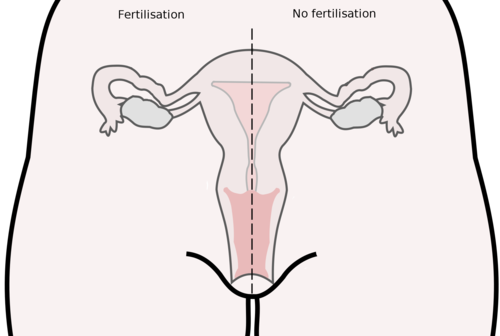
Learner-dependent answer
The following diagram shows an example of something that the learners might produce. Learners might battle to do this. A suggestion is to produce a sketch on the board and go through it with them, filling in the annotations. Do not simply draw it up and get learners to copy down the answers. Ask for their input and possibly get different learners to come up to the board to draw in different stages.
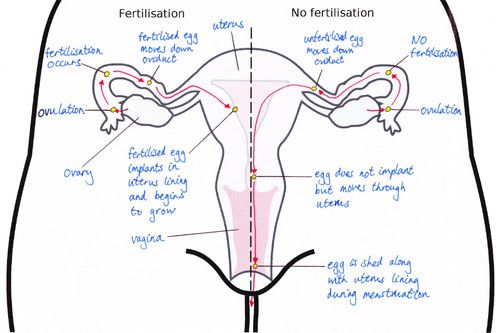
Pregnancy begins the moment the female egg cell is fertilised by the male sperm cell. This is then called a zygote.
This video shows the development of a baby from fertilisation to birth
The zygote will then start to divide and grow as it moves down the oviduct. It will then implant in the uterus lining, where it will continue to grow. The fertilised egg is now called an embryo and undergoes cell division over and over again. This forms a cluster of cells with the different cells differentiating to become the specialised cells, tissues and organs that make up the human body.
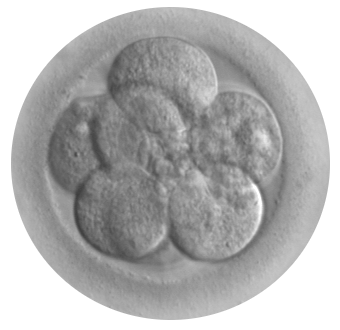
Where the embryo implants into the spongy, blood-vessel rich lining of the uterus, some of the cluster of cells that formed after fertilisation form the placenta. The placenta is partly formed by the mother and partly by the embryo. The embryo develops an umbilical cord to attach itself to the placenta. The embryo can receive food and oxygen and remove its wastes through the umbilical cord and placenta.
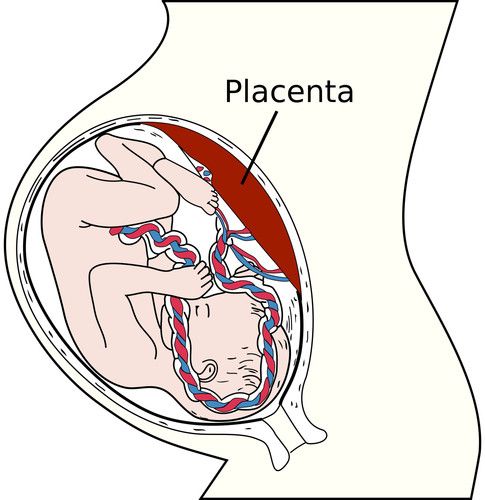
Video on fertilisation and early pregnancy.
In humans, pregnancy is about 40 weeks (9 months). We call this the gestation period. Towards the end of the pregnancy, the uterus starts to contract. This pushes the head of the foetus into the vagina (birth canal). After the head has appeared the rest of the body comes out quite quickly. The last to come out is the placenta.
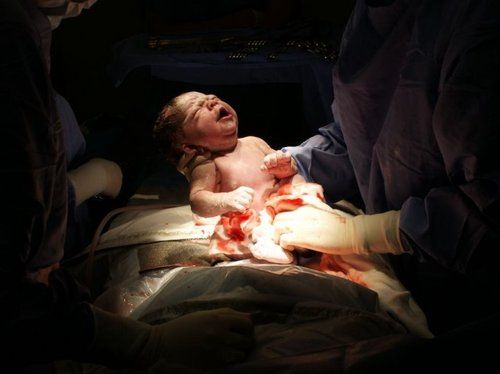
This is an optional activity, depending on your class.
Many couples, for various reasons, are unable to fall pregnant. A surrogate mother can be impregnated with the couple's fertilised embryos and can therefore carry the couple's baby to full term. South African law only allows certain individuals to do this, it is not just available to anybody.
INSTRUCTIONS:
There are many ethical issues concerning surrogacy:
Use the following lines to write down some notes on any other points your group discusses:
Learner-dependent answer
During pregnancy, what the mother eats, drinks and takes into her body has been shown to directly affect the unborn child. Other substances like smoking, alcohol and drugs have a negative influence on an unborn baby.
Hearing is one of the first senses to develop in a foetus. So it is thought that unborn babies can hear and are affected by sounds whilst in the womb.
The placenta transports nutrients and oxygen to the foetus, and removes metabolic waste products and carbon dioxide. However, it cannot differentiate between nutrients and harmful products, such as nicotine, alcohol or drugs. If the mother uses these substances during pregnancy, they will most likely pass through the placenta to the foetus causing great harm to the unborn child.
Pregnant mothers who drink alcohol during pregnancy may cause irreversible birth defects in their unborn babies. This is called Foetal Alcohol Syndrome.
The University of Stellenbosch has a website on FAS http://www.sancawc.co.za/master/article.php?id=14.
Anyone who is sexually active and who wants to prevent an unwanted or unplanned pregnancy can take certain precautions.
'Contra-' means against, so 'contra-ception' means against conception.
There are a range of different contraceptives that can be used to prevent pregnancy. There are four different types of contraceptives:
It may be possible to get examples of these different types of contraceptives for the learners to have a look at. Many clinics will have samples that can be used for educational purposes. They are normally very willing to hand out stock that has passed its expiry date and is only to be used for educational purposes.
INSTRUCTIONS:
|
Contraceptive |
Description |
Classification |
|
Male condoms 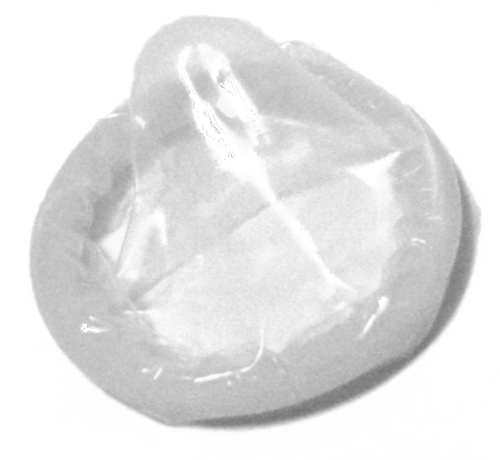 |
These thin sheaths of rubber are placed over the erect penis before inserting it into the vagina. When the male ejaculates the sperm and seminal fluid is caught in the condom and cannot enter the cervix. |
|
|
Diaphragm 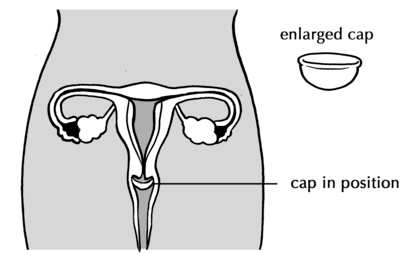 |
The diaphragm is a small rubber cap that is placed at the entrance to the uterus before sexual intercourse to create a seal and prevent sperm from entering the uterus. |
|
|
Tubal ligation in women 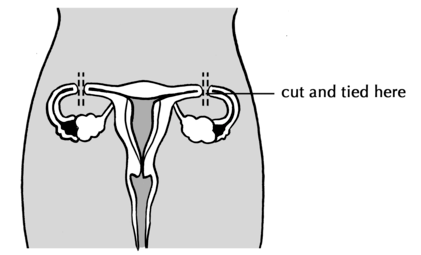 |
A surgical procedure in women in which the the oviducts are cut and tied which prevents mature eggs from reaching the uterus for fertilisation. |
|
|
Oral contraceptive pill 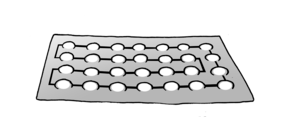 |
Often referred to as "the Pill", it is taken every day by mouth. It contains a combination of female hormones which prevents ovulation each month. |
|
|
Female intra-uterine device (IUD) 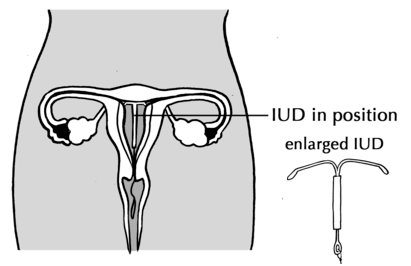 |
A small 'T'-shaped device is inserted into the uterus and prevent fertilisation. It is a long-acting, reversible contraception as the device may be removed again. It is not suitable for women who have not yet had a baby and must be inserted by a doctor. |
|
|
Vasectomy 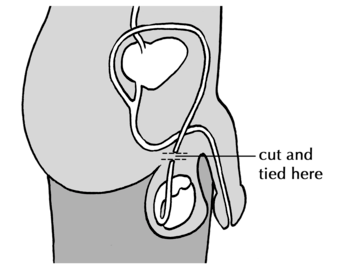 |
A surgical procedure in males in which the vas deferens is cut and tied. Sperm are therefore prevented from becoming part of the ejaculate. |
|
Contra ce ptive |
Description |
Classification |
|
Male condoms 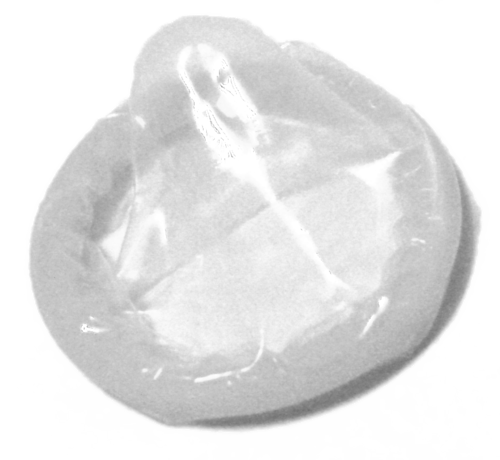 |
These thin sheaths of rubber are placed over the erect penis before inserting it into the vagina. When the male ejaculates the sperm and seminal fluid is caught in the condom and cannot enter the cervix. |
Barrier |
|
Diaphragm 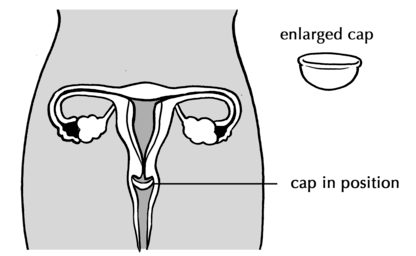 |
The diaphragm is a small rubber cap that is placed at the entrance to the uterus before sexual intercourse to create a seal and prevent sperm from entering the uterus. |
Barrier |
|
Tubal ligation in women 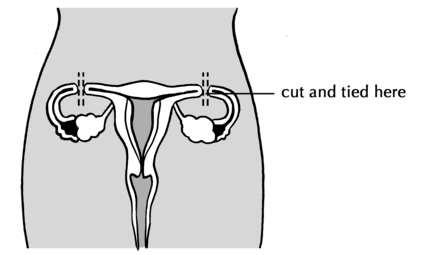 |
A surgical procedure in women in which the the oviducts are cut and tied which prevents mature eggs from reaching the uterus for fertilisation. |
Sterilisation |
|
Oral contraceptive pill 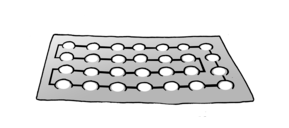 |
Often referred to as "the Pill", it is taken every day by mouth. It contains a combination of female hormones which prevents ovulation each month. |
Hormonal |
|
Female intra-uterine device (IUD) 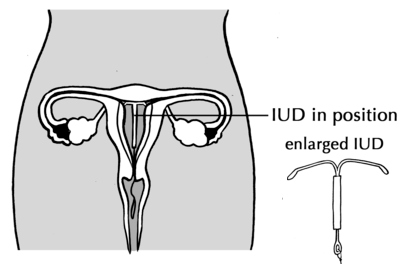 |
A small 'T'-shaped device is inserted into the uterus and prevent fertilisation. It is a long-acting, reversible contraception as the device may be removed again. It is not suitable for women who have not yet had a baby and must be inserted by a doctor. |
Intra-uterine device |
|
Vasectomy 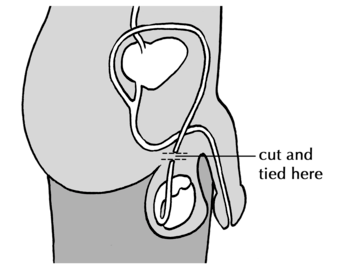 |
A surgical procedure in males in which the vas deferens is cut and tied. Sperm are therefore prevented from becoming part of the ejaculate. |
Sterilisation |
Some intra-uterine devices can also be classified as hormonal as they contain progesterone. The progesterone also prevents fertilisation, by increasing the cervical mucous, suppressing the endometrium and sometimes also inhibiting ovulation. The IUDs with copper are non-hormonal and also prevent fertilisation as the copper acts as a natural spermicide within the uterus.
Sexual intercourse with many different partners is very risky behaviour as there are many diseases that are transmitted through the fluids involved in the sexual act. We call these Sexually Transmitted Diseases (STDs). There are many different STDs, for example; HIV/AIDS, Herpes virus, Syphilis, Gonorrhoea and genital warts.
Being faithful to one partner limits your chances of contracting STDs. If you know that your partner has an STD he or she can either get medical treatment for this and/or you can take the necessary precautions to prevent contracting the disease. One of the most popular precautions to prevent the transmission of STDs is for the male partner to wear a condom. However, condoms can break and this can expose you to an STD, so you still have to be careful.
Need to know more about STDs? http://www.cdc.gov/std/general/default.htm [link]or http://kidshealth.org/teen/sexual_health/
Many women who become pregnant might feel that they do not want or cannot care sufficiently for their unborn baby. Some may feel that they do not have the money to support another baby if they already have other children. When teenage girls become pregnant, many might feel that they would still like to complete their schooling and could not also raise a child. Other women might not want the baby as it might possibly be a result of rape or incest. Many women have many different reasons why they do not want to be pregnant or raise a child.
There are of course various choices that they can make in such a situation.
The following activity will require learners to do some research and interviews and then come back into class to hold a forum discussion. A suggestion is to get learners to start doing some research and thinking about the topics in the days leading up to this lesson. Below is some more information on each of the types of choices a woman is faced with when she experiences an unwanted pregnancy. Read through this first so that you are familiar with the choices before the lesson so that you can help learners with their forum discussions.
This activity relates to Life Orientation. This activity was specifically included at the end of the section to allow for research to occur before the forum discussion. Break the class up into groups of 6 and allow them to move into different areas of the classroom, or perhaps even move outside if space permits. Each group must then conduct their forum discussion according to the instructions and guidelines below.
You, the teacher, can spend a little time with each group to make sure they are on track and discussing the topic. Use the notes provided on the different options for an unwanted pregnancy if you need to provide a group with some background information or some guidelines about what to discuss. Encourage learners to express their points of view and why they believe something.
An alternative is to have one discussion forum in the front of the class and give different learners the chance to sit up front on the panel, and you can be the moderator.
This activity does not need to be assessed and is more for personal education, and a chance for learners to practise debating.
Hold a forum discussion regarding the choices women have when they do not want to be pregnant or raise a child. Before the discussion, do research and interviews with your parents or caregivers, with health professionals or ask your Life Orientation teacher.
How to hold a forum discussion:
In a forum discussion, experts are asked to sit on a panel and give their opinion about a particular topic. There are specific roles in a forum discussion:
Rules for a forum discussion:
Record your findings:
Use the space below to record the findings from the forum discussion explaining what choices women have when faced with an unwanted pregnancy.
Learner-dependent answer
Concept map
This concept map shows all that we have learned about reproduction in humans. Complete it by filling in the blank spaces. You might find this quite tricky, but you need to learn to "read" a concept map by constructing sentences. For example, "Human reproduction can take place once sexual organs are mature. They mature during puberty which is initiated by ….............. The …............ releases hormones which stimulate the ovaries and testes." What is this gland which initiates puberty and releases hormones, and which hormones do the ovaries and testes release? Fill this in below.
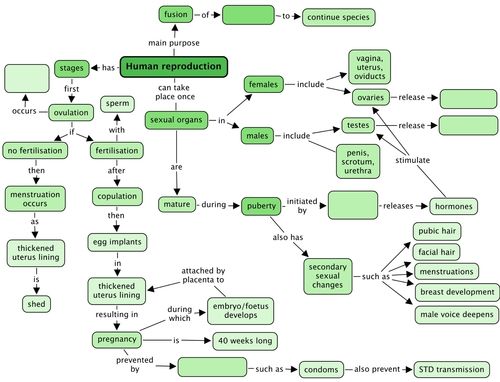
Teacher's version
Help your learners to fill in the blanks by asking questions such as, "How often does ovulation occur?" (It occurs once per month).
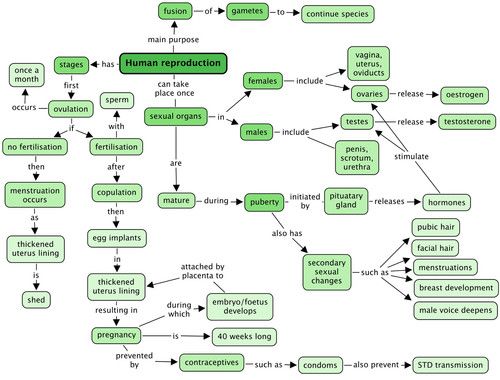
Explain the changes that occur to the male and female body during puberty. [10 marks]
For females, these include: breasts develop, pubic hair starts to grow, underarm hair grows, body shape changes, ovaries mature, acne develops in some individuals. For males, these include: penis grows and becomes larger, testes mature, pubic hair starts to grow, facial hair grows, underarm, chest and back hair grows, voice deepens, acne develops in some individuals.
Describe the hormonal control of the start of puberty. Name the organs involved and the hormones. [5 marks]
At the onset of puberty, hormones are released into the blood (these hormones were not specifically named at this level). These hormones travel in the blood and stimulate the reproductive organs. In females, the ovaries are stimulated to produce oestrogen and in males, the testes are stimulated to produce testosterone.
At what stage of the reproductive cycle can one say that a woman is pregnant? [1 mark]
When the egg has been fertilised by a sperm (ie fertilisation), the woman is now pregnant.
There is a urban legend or myth that says that a girl cannot fall pregnant the first time she has sexual intercourse. Think carefully about everything you have learnt about conception and fertilisation, and discuss whether this myth is true or false. [2 marks]
It can be true if the girl has sex before her reproductive organs have matured and therefore before she is able to ovulate. In this instance she will not be able to fall pregnant. If the woman's reproductive organs have matured and she has started to menstruate and ovulate, then she can fall pregnant after sexual intercourse, even if it is the first time. Thus in this instance the myth is not true.
Explain why you think it is important for someone who considers becoming sexually active to know how reproduction occurs in humans. [1 mark]
Learners need to indicate that once someone knows the facts about conception they will be able to take (realistic) precautions to avoid unwanted pregnancies and disease. The will also not believe all the myths and make sensible decisions.
Imagine someone who has many sexual partners asks you for advice on which contraceptive to use. What advice would you give them? [3 marks]
Someone who has many sexual partners stands a high risk of contracting an STD. To prevent this and to prevent an unwanted pregnancy learners should be able to say that they should use a condom during intercourse. They could also possibly suggest that the person limits the number of sexual partners that they have, and if they are in a relationship, then both of them should remain faithful to one partner. Alternatively, if they do continue with many partners, the person should try establish the status of these partners before intercourse, and still use a condom. The person should also be advised to have regular check ups to know their status.
Some people have religious reasons for not using contraceptives. Decide whether you agree with them or not and why. Write a short letter to the editor of local newspaper expressing your concerns about contraceptives from this specific point of view. [6 marks]
Learner-dependent answer
Learners should be able to see the different points of view regarding this issue and reference the debate on this topic that was held earlier in this chapter. There is no right answer, rather the focus should be on the fact that learners can justify their opinions and express themselves. They should draw on this and write their letter in this frame of reference. NB: Learners are not criticizing anyone's religion or culture in this activity.
Do you think schools should teach learners about different contraceptives? Why do you say so? [3 marks]
Learner-dependent answer. Check that learners are able to justify their answer and provide a reason for what they think.
During pregnancy the pregnant mother needs to take care of herself in order to provide a healthy and safe environment for the unborn child. Your local clinic has asked you to produce a brochure that they can display in their waiting room for first-time mothers. Write a detailed list of instructions for a pregnant woman explaining what she needs to do to keep herself and her unborn baby healthy. You can chose how you want to do this - perhaps a list of "Do's" and "Dont's", or else provide some headings under which you can list some instructions such as "Diet" , "Lifestyle", etc. [6 marks]
Learners should refer to the diet and lifestyle choices of the pregnant mother, specifically noting that pregnant mothers who consume drugs and alcohol, also pass these on to the unborn baby through the placenta, resulting in irreversible damage to the unborn child. The mother should therefore avoid these during pregnancy.
this last question does not need to be assessed.
Total [37 marks]
|
Previous
Chapter 2: Systems in the human body
|
Table of Contents |
Next
Chapter 4: Circulatory and respiratory systems
|